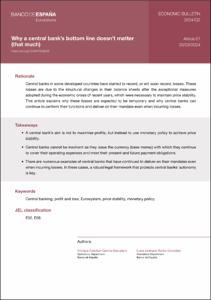Registro completo de metadatos
| Campo DC | Valor |
|---|---|
| dc.contributor.author | Esteban García-Escudero, Enrique |
| dc.contributor.author | Romo González, Luna Azahara |
| dc.date.accessioned | 2024-03-19T13:42:16Z |
| dc.date.available | 2024-03-19T13:42:16Z |
| dc.date.issued | 2024-03-20 |
| dc.identifier.issn | 1695-9086 (en línea) |
| dc.identifier.issn | 1130-4987 (en papel) |
| dc.identifier.uri | https://repositorio.bde.es/handle/123456789/36255 |
| dc.description.abstract | Rationale Central banks in some developed countries have started to record, or will soon record, losses. These losses are due to the structural changes in their balance sheets after the exceptional measures adopted during the economic crises of recent years, which were necessary to maintain price stability. This article explains why these losses are expected to be temporary and why central banks can continue to perform their functions and deliver on their mandate even when incurring losses. Takeaways •A central bank’s aim is not to maximise profits, but instead to use monetary policy to achieve price stability. •Central banks cannot be insolvent as they issue the currency (base money) with which they continue to cover their operating expenses and meet their present and future payment obligations. •There are numerous examples of central banks that have continued to deliver on their mandates even when incurring losses. In these cases, a robust legal framework that protects central banks’ autonomy is key. |
| dc.format.extent | 14 p. |
| dc.language.iso | en |
| dc.publisher | Banco de España |
| dc.relation.ispartof | Economic Bulletin / Banco de España, 2024/Q2, 01 |
| dc.relation.hasversion | Versión en español 123456789/36273 |
| dc.rights | Reconocimiento-NoComercial-CompartirIgual 4.0 Internacional (CC BY-NC-SA 4.0) |
| dc.rights | In Copyright - Non Commercial Use Permitted |
| dc.rights.uri | https://creativecommons.org/licenses/by-nc-sa/4.0/deed.es_ES |
| dc.rights.uri | http://rightsstatements.org/vocab/InC-NC/1.0/ |
| dc.subject | Central banking |
| dc.subject | Profit and loss |
| dc.subject | Eurosystem |
| dc.subject | Price stability |
| dc.subject | Monetary policy |
| dc.subject | Política monetaria |
| dc.subject | Contabilidad bancaria |
| dc.subject | Estabilidad de precios |
| dc.title | Why a central bank’s bottom line doesn’t matter (that much) |
| dc.type | Artículo |
| dc.identifier.bdebib | 000475389 |
| dc.identifier.bdepub | ECBU-2024-Q2-01 |
| dc.subject.bde | Bancos centrales y otras autoridades monetarias |
| dc.publisher.bde | Madrid : Banco de España, 2024 |
| dc.subject.jel | E52 |
| dc.subject.jel | E58 |
| dc.identifier.doi | https://doi.org/10.53479/36255 |












